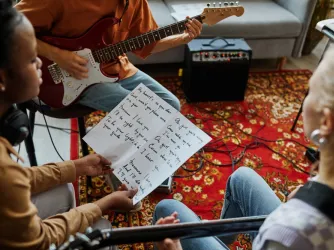Table of Contents
Dearth of Critical Thinking on Display as NKU Library Removes Anti-Klan Artwork
A recent article in The Northerner, of Northern Kentucky University (NKU), reports that an art display has been moved from its place in an NKU library after administrators received complaints over its depiction of a member of the Ku Klux Klan.
More specifically, the work is an award-winning triptych of images by NKU professor Hanz Schellhas titled "First Class, Second Class," which the professor created during his days as a student at NKU as a critique of modern race relations. An NKU website describes the motivation and methodology of the piece:
Based on his own experience working for social justice in Cincinnati, Schellhas depicted a Klansman whose large portrait in the center of the triptych was created entirely with ink applied by rubber stamps with the words "FIRST CLASS." Flanking the Klansman on either side were smaller portraits of non-Klan protestors whose inked images were created with "second class" stamps.
The Northerner further notes that "Schellhas said he created the trio of images after witnessing how Cincinnati Police handled race riots in 2003. The riots began after two black men died within 24 hours of each other while in police custody."
Here is the piece in the context in which it was displayed:
Despite the message of the piece, the artwork's central image prompted complaints from visitors to NKU's Steely Library that the artwork implied support of the Ku Klux Klan, even with Schellhas' statement hanging next to it. The library responded by removing the artwork from its prominent location. Library provost Arne Almquist says that "[w]e're regrouping and trying to determine how to best display it to put it in context," though I don't quite know how much more "context" they could give it. Currently, according to The Northerner, "[t]he art has been moved to the Steely Library's archives, where it can be viewed by request."
A couple of observations here: First, Almquist maintains that no one's free speech rights have been violated by this decision, and he is most likely right. The article notes that "First Class, Second Class" was acquired from Schellhas by NKU and, as the owner of the work, NKU is free to display (or not display) the piece as it chooses, however misguided and misinformed the sentiments going into such a decision may be. This separates this instance somewhat from FIRE's ongoing case at Gainesville State College in Georgia, where administrators removed professor Stanley Bermudez's painting "Heritage?", which features two KKK members superimposed onto a confederate flag (below) and is a statement by Bermudez on his complicated relationship with the flag as a southern Hispanic. After complaints were received from outside the university over the painting's critical message, GSC President Martha Nesbitt removed the painting from its place in a faculty art show. FIRE still awaits an explanation from Nesbitt on her decision to censor Bermudez's work.
NKU, on the other hand, is free to self-censor its own expression in response to complaints from the community. While I'm troubled by its decision to do so in this case, I'm more troubled by the nature of the complaints, and the demonstrated inability or unwillingness of some to make the minimal effort necessary to understand the artwork's message. It's hard to believe that the artwork was taken as support of the KKK's cause when the art was a statement against racism. This incredible hostility to critical thinking is nothing short of alarming.
What's more, such illogical reactions to depictions of the Klan seem to be endemic to the university community, as anyone who remembers the case of Keith John Sampson at Indiana University-Purdue University Indianapolis (IUPUI) will know. In that case, the IUPUI student-employee was found guilty of racial harassment simply for reading Todd Tucker's book Notre Dame vs. the Klan: How the Fighting Irish Defeated the Ku Klux Klan during his work breaks. This decision was reached by IUPUI's Affirmative Action Office (AAO) solely on the basis of the book's cover, which features an image of several Klan members in their trademark white robes and hoods. Sampson was punished even after pointing out the anti-Klan nature of the book, and the fact that it was available in IUPUI's own library. The AAO couldn't have been less interested in this defense, finding Sampson responsible for "openly reading the book related to a historically and racially abhorrent subject."
The irony of this reluctance to allow portrayals of the Klan in any context to enter the marketplace of ideas is that nothing has been better for defeating the Klan's message than ensuring its ability to be expressed in the open. (Malcolm Gladwell amusingly described this in The Tipping Point, pointing out how the Klan became the subject of widespread ridicule, and went into decline, after its various manifestos and tracts received mass exposure.) NKU and other universities who seem to be determined to make it impossible for such a process to take place in the future are terribly shortsighted.
Recent Articles
Get the latest free speech news and analysis from FIRE.

Why FIRE is suing Secretary of State Rubio — and what our critics get wrong about noncitizens’ rights


LAWSUIT: FIRE challenges unconstitutional provisions Rubio uses in crusade to deport legal immigrants over protected speech
